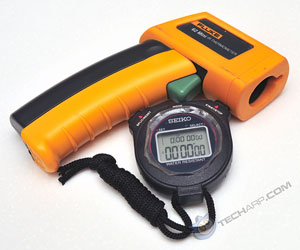Testing The DataTraveler Elite 3.0
The Testbed
Processors |
||
Motherboard |
||
Memory |
Two Kingmax 2 GB DDR3-1333 modules |
|
Graphics Card |
||
USB Controllers |
USB 2.0 : Intel P67 |
|
USB Flash Drives |
32 GB Kingston DataTraveler Ultimate 3.0 G2 |
|
Operating System |
Microsoft Windows 7 64-bit |
Testing Methodology
We tested in Microsoft Windows 7 with the latest updates. We chose to use IO Meter 2008 as well as our own suite of test files. Here are the details of the two sets of test files we used :
- Large Files : 29 high-resolution photos (250,030,840 bytes)
- Small Files : 436 low-resolution photos (250,001,809 bytes)
All transfer rate tests were timed using a Seiko WC73-4000 stopwatch with a rated accuracy of 10 ms. A minimum of 3 test runs were performed, with additional test runs undertaken if the results were off by more than half a second. The closest group of 3 run times was averaged to obtain the final result.
 |
The case temperature results were obtained using a Fluke 62 Mini infra-red thermometer. The Load temperature test was carried out after at least 5 minutes running IO Meter (512 KB sequential read), with IO Meter continuing to run. The drives were allowed to idle for a minimum of 15 minutes before the Idle temperature test was performed. A minimum of 5 test spots were examined on each case, with the maximum test result used.
Maximum Case Temperature
We monitored the surface temperature of 6 USB flash drives during their benchmarks. The following chart shows their operating temperature range, from idle to maximum load. Please note that instead of giving you the absolute numbers, we are showing the temperature delta, which is the difference between the actual temperature and the ambient room temperature.

Surprisingly, the Kingston DataTraveler Elite 3.0 was a very hot drive, much hotter than the DataTraveler Ultimate 3.0 Gen. 2 or even the very hot first-generation DT Ultimate 3.0. In fact, the Elite 3.0 drive was almost as hot while idling in its USB 2.0 mode as the Ultimate 3.0 Gen. 2 at full load! We have no idea why this is so. Perhaps the more compact casing made for much better thermal transfer out of the drive.
Editor : Kingston confirmed that due to the thinner case, the heat from the drive components were directly transferred to the case, resulting in the much higher case temperature. However, they assured us that this is within normal operating parameters and will not affect the operation of the drive. If this is the case (higher temperature due to better thermal transfer, and not higher power consumption), then it is actually a good thing as it means more efficient cooling for the chips inside.
Support Tech ARP!
If you like our work, you can help support out work by visiting our sponsors, participate in the Tech ARP Forums, or even donate to our fund. Any help you can render is greatly appreciated!
<<< The 16 GB DataTraveler Elite 3.0, Usable Capacity, Specifications : Previous Page | Next Page : Sustained Read & Write Transfer Rates >>>







 Add to Reddit
Add to Reddit
